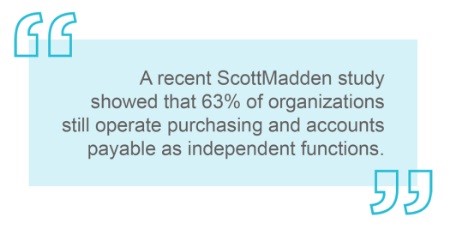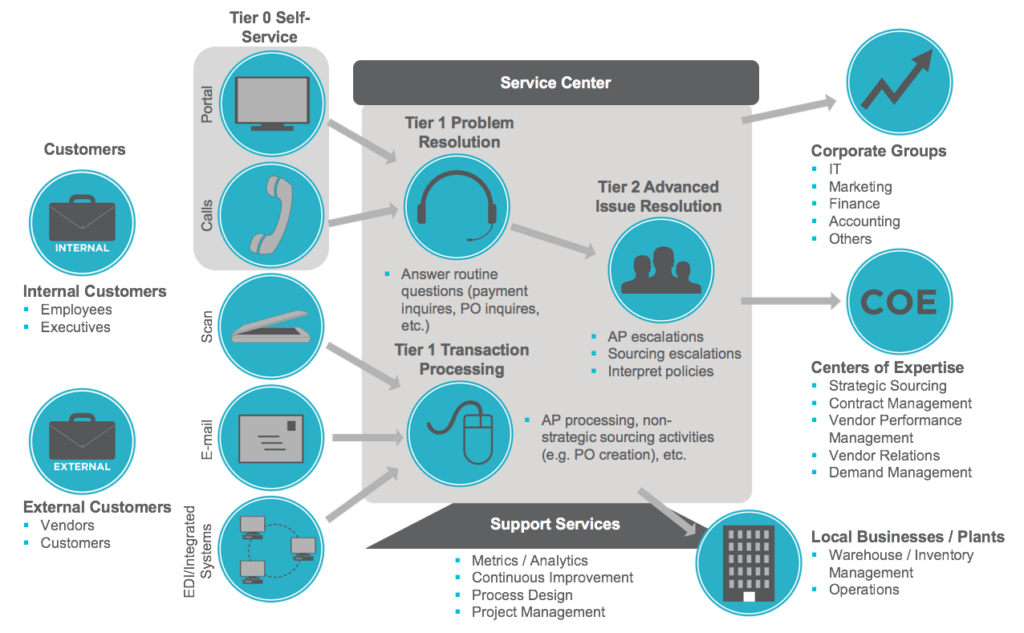
 This best-selling food manufacturing brand began as a small family-owned butcher shop, but has since grown to a household name, with hundreds of employees and distribution in more than 40 countries. ScottMadden developed an end-to-end procure-to-pay (P2P) model that could accommodate the expected growth of this organization.
This best-selling food manufacturing brand began as a small family-owned butcher shop, but has since grown to a household name, with hundreds of employees and distribution in more than 40 countries. ScottMadden developed an end-to-end procure-to-pay (P2P) model that could accommodate the expected growth of this organization.
Before ScottMadden’s engagement, the company’s procurement and accounts payable processes were managed by two separate internal organizations. As the company evolved, it wanted to establish an end-to-end P2P model that would operate across traditional organizational boundaries. The goal was to eliminate disconnects between the two functions, increase efficiency for transactional work, and get better results from its supply base.
Establishing an integrated P2P model is a top priority for many companies dealing with disconnected sourcing, purchasing, and accounts payable functions which are often plagued with challenges, such as decreased efficiency and reduced stakeholder satisfaction. Ultimately, creating an integrated model and organizing more effectively to differentiate transactional from strategic work helped the company streamline and advance its P2P capabilities.
The company’s procurement and accounts payable departments were divided into two distinct functions that reported to operations and finance, respectively. Transactional work and issue resolution were handled by the same personnel and the “tyranny of the urgent” prevented both departments from being able to pursue more strategic opportunities.
Additionally, current methods to handle many transactions were manual, and there was little insight into spend savings opportunities, supplier performance, or invoice discount and compliance opportunities. To feel comfortable with the changes necessary to address these issues, the company needed stakeholders to understand why it was necessary to alter the current system, how the changes would be implemented, and which functions would be affected.
ScottMadden designed a tiered service delivery model to take advantage of cost savings and opportunities for more efficient work processes discovered by ScottMadden in its initial P2P assessment.
This delivery model separates work by type, aligning employee skills with the work performed. For example, transactional service roles are consolidated to handle incoming vendor calls and process on-contract buys, which creates additional time for other procurement personnel to pursue savings and performance improvement opportunities within their supplier networks.
Representatives from the organization’s finance, procurement, and information technology groups were part of the cross-functional core team assembled to work closely throughout the project. Early project phases included critical data collection and stakeholder interviews to begin building a clear understanding of the current challenges. ScottMadden’s proprietary Work Activity Assessment was conducted to measure the type and magnitude of work across the company for a comprehensive set of P2P activities. The team conducted workshops to discuss, analyze, and assess leading practices, and a detailed performance metrics analysis was developed to quantify current performance against established benchmarks.
Following confirmation of the current situation and highest-impact opportunity, ScottMadden worked closely with the company’s stakeholders to design a new P2P delivery model and execution plan. The project team also evaluated the types of supporting technologies required to enable the model, steps to implement changes, and change implications that must be managed to effectively deploy the new model. Lastly, ScottMadden provided a thoroughly documented analysis of the costs and benefits associated with the projected performance of the new model.
The diagram below depicts ScottMadden’s leading practice P2P delivery model.

As part of the business case, ScottMadden identified improvement opportunities in four key P2P areas:
With an internal rate of return in excess of 200% and a payback period of two years, the company expects to implement the proposed model over the coming years. This timeline allows the organization to implement change at a rate that best fits the family oriented culture.
To learn more about how ScottMadden can help solve your P2P challenges, contact us today.
View MoreSussex Economic Advisors is now part of ScottMadden. We invite you to learn more about our expanded firm. Please use the Contact Us form to request additional information.